Acetaminophen induces JNK/p38 signaling and activates the caspase-9-3-dependent cell death pathway in human mesenchymal stem cells
- Authors:
- Giou‑Teng Yiang
- Yung‑Lung Yu
- Ko‑Ting Lin
- Jen‑Ni Chen
- Wei‑Jung Chang
- Chyou‑Wei Wei
-
Affiliations: Department of Emergency Medicine, Taipei Tzu Chi Hospital, Buddhist Tzu Chi Medical Foundation, New Taipei 231, Taiwan, R.O.C., Graduate Institute of Cancer Biology and Center for Molecular Medicine, China Medical University, Taichung 404, Taiwan, R.O.C., Department of Nutrition, Master Program of Biomedical Nutrition, Hungkuang University, Shalu, Taichung 433, Taiwan, R.O.C. - Published online on: June 19, 2015 https://doi.org/10.3892/ijmm.2015.2254
- Pages: 485-492
This article is mentioned in:
Abstract
 |
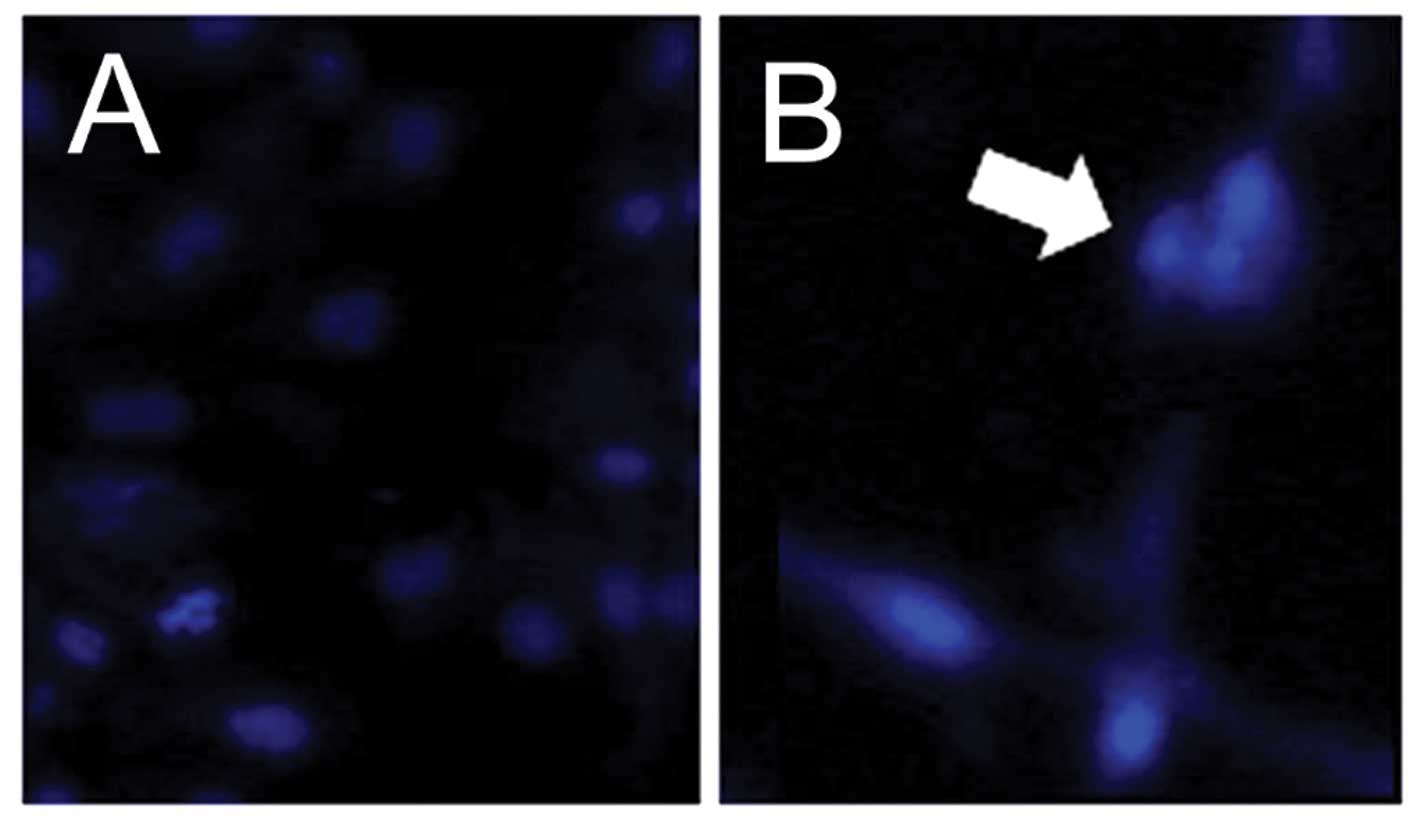 |
 |
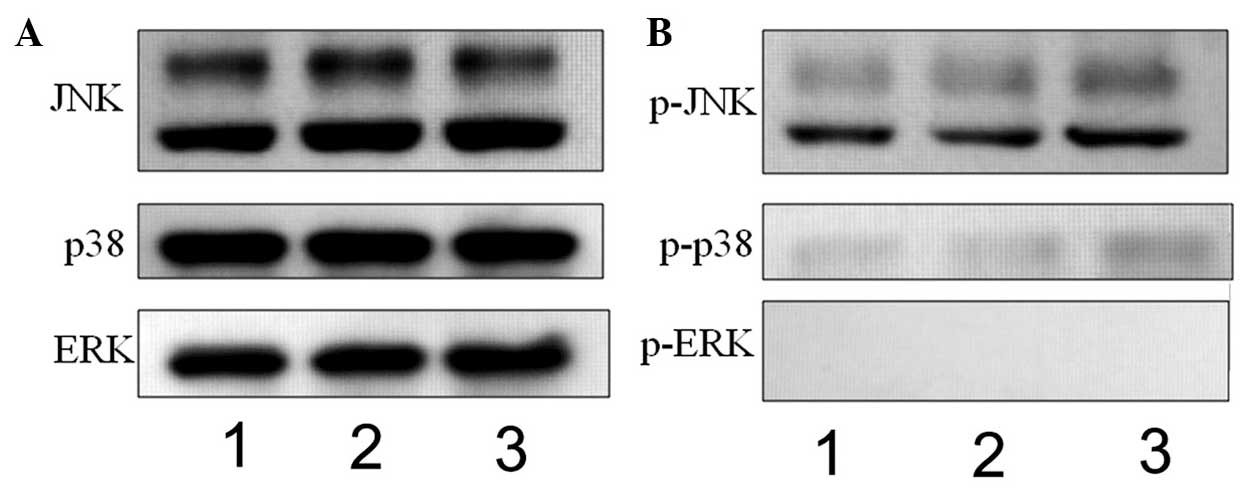 |
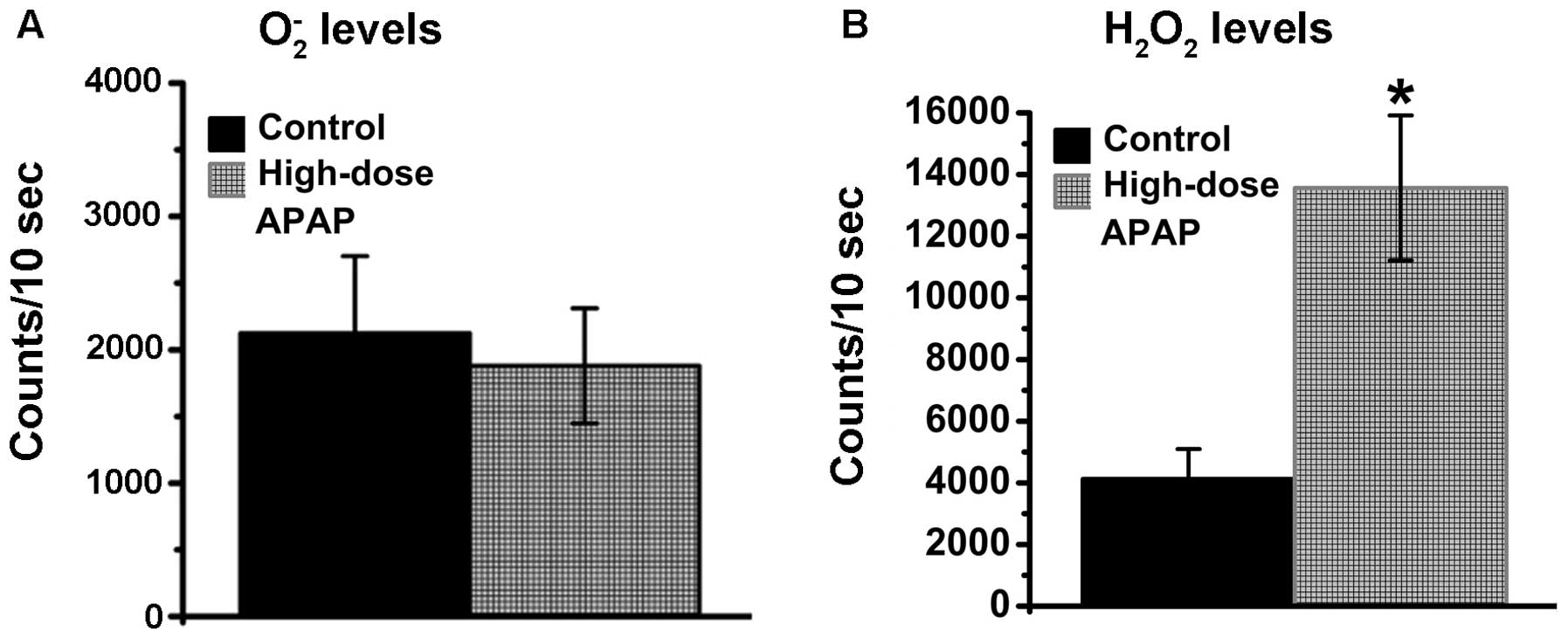 |
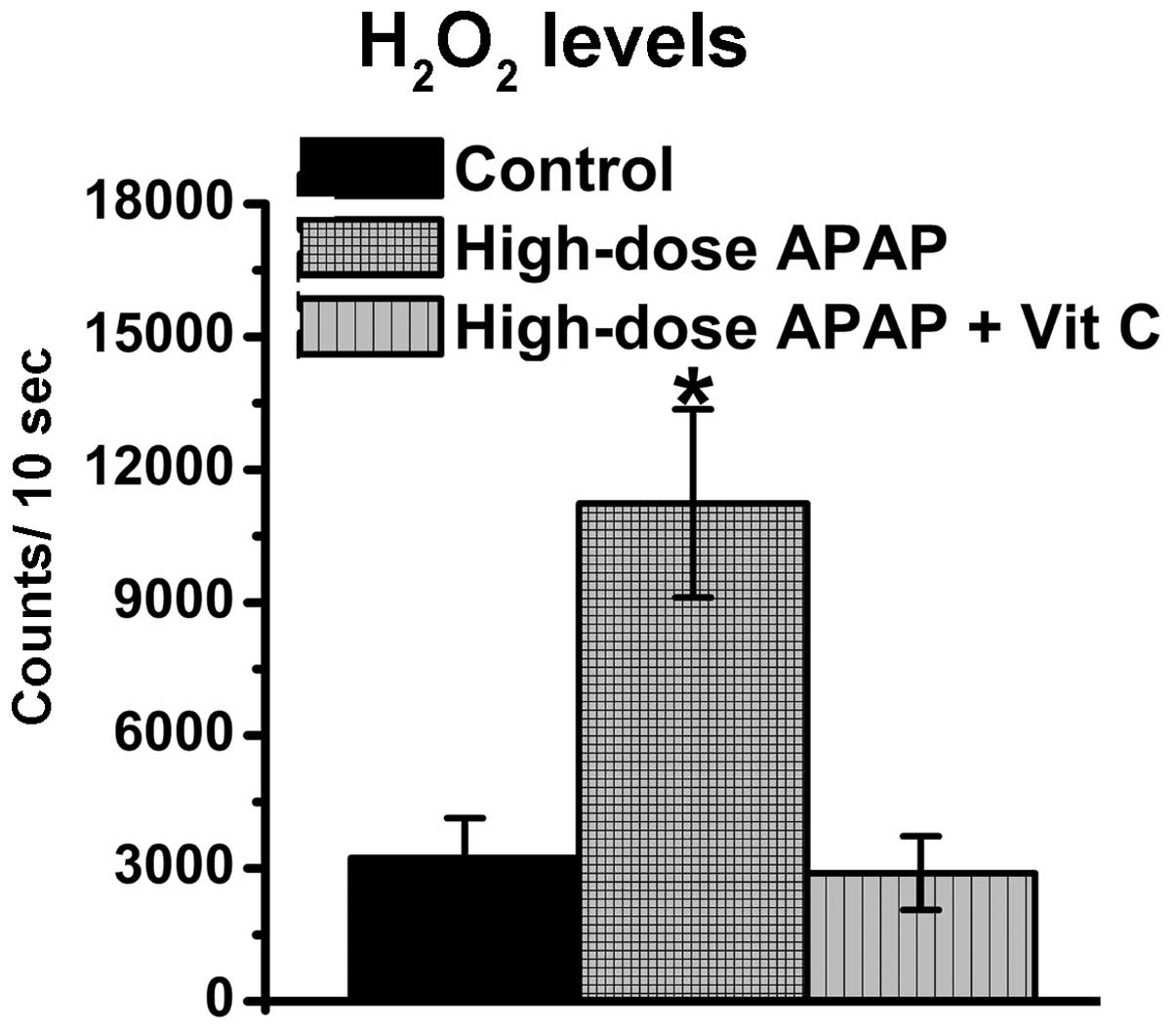 |
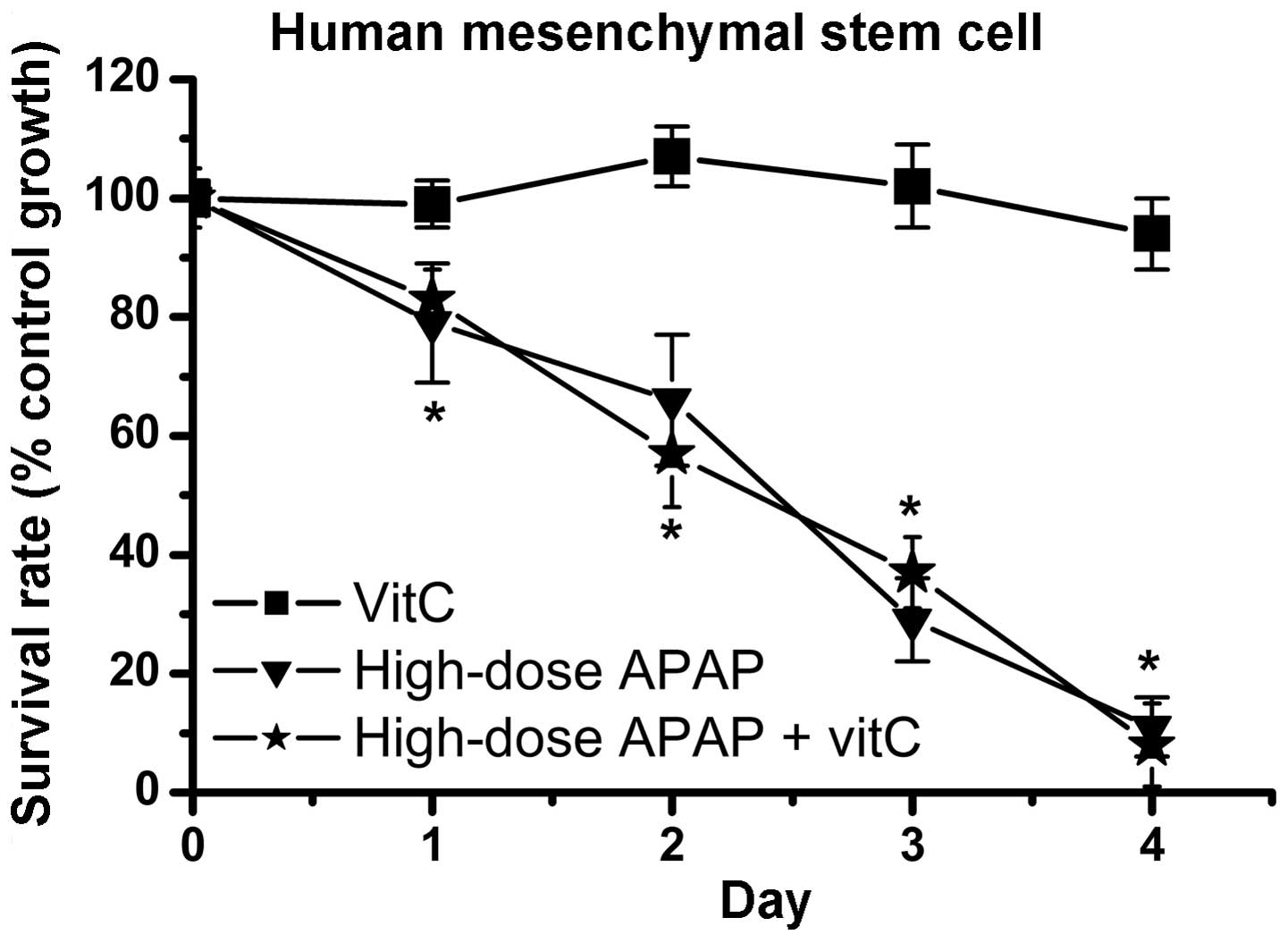 |
|
Cuzzolin L, Antonucci R and Fanos V: Paracetamol (acetaminophen) efficacy and safety in the newborn. Curr Drug Metab. 14:178–185. 2013. | |
|
Klotz U: Paracetamol (acetaminophen) - a popular and widely used nonopioid analgesic. Drug Res. 62:355–359. 2012. | |
|
Section on Clinical Pharmacology Therapeutics, Committee on Drugs; Sullivan JE and Farrar HC: Fever and antipyretic use in children. Pediatrics. 127:580–587. 2011. View Article : Google Scholar : PubMed/NCBI | |
|
Rumack BH: Acetaminophen misconceptions. Hepatology. 40:10–15. 2004. View Article : Google Scholar : PubMed/NCBI | |
|
Hawton K, Bergen H, Simkin S, et al: Impact of different pack sizes of paracetamol in the United Kingdom and Ireland on intentional overdoses: a comparative study. BMC Public Health. 11:4602011. View Article : Google Scholar : PubMed/NCBI | |
|
Hawton K, Townsend E, Deeks J, et al: Effects of legislation restricting pack sizes of paracetamol and salicylate on self poisoning in the United Kingdom: before and after study. BMJ. 322:1203–1207. 2001. View Article : Google Scholar : PubMed/NCBI | |
|
Daly FF, Fountain JS, Murray L, Graudins A and Buckley NA; Panel of Australian and New Zealand clinical toxicologists: Guidelines for the management of paracetamol poisoning in Australia and New Zealand - explanation and elaboration. A consensus statement from clinical toxicologists consulting to the Australasian poisons information centres. Med J Aust. 188:296–301. 2008.PubMed/NCBI | |
|
Young RJ: Dextropropoxyphene overdosage. Pharmacological considerations and clinical management. Drugs. 26:70–79. 1983. View Article : Google Scholar : PubMed/NCBI | |
|
Simkin S, Hawton K, Kapur N and Gunnell D: What can be done to reduce mortality from paracetamol overdoses? A patient interview study. QJM. 105:41–51. 2012. View Article : Google Scholar | |
|
McGill MR, Li F, Sharpe MR, et al: Circulating acylcarnitines as biomarkers of mitochondrial dysfunction after acetaminophen overdose in mice and humans. Arch Toxicol. 88:391–401. 2014. View Article : Google Scholar : | |
|
Ghosh J, Das J, Manna P and Sil PC: Acetaminophen induced renal injury via oxidative stress and TNF-alpha production: therapeutic potential of arjunolic acid. Toxicology. 268:8–18. 2010. View Article : Google Scholar | |
|
Chandrasekaran VR, Wan CH, Liu LL, Hsu DZ and Liu MY: Effect of sesame oil against acetaminophen-induced acute oxidative hepatic damage in rats. Shock. 30:217–221. 2008. | |
|
Galal RM, Zaki HF, Seif El-Nasr MM and Agha AM: Potential protective effect of honey against paracetamol-induced hepatotoxicity. Arch Iran Med. 15:674–680. 2012.PubMed/NCBI | |
|
Abdul Hamid Z, Budin SB, Wen Jie N, Hamid A, Husain K and Mohamed J: Nephroprotective effects of Zingiber zerumbet Smith ethyl acetate extract against paracetamol-induced nephrotoxicity and oxidative stress in rats. J Zhejiang Univ Sci B. 13:176–185. 2012. View Article : Google Scholar : PubMed/NCBI | |
|
Kheradpezhouh E, Panjehshahin MR, Miri R, et al: Curcumin protects rats against acetaminophen-induced hepatorenal damages and shows synergistic activity with N-acetyl cysteine. Eur J Pharmacol. 628:274–281. 2010. View Article : Google Scholar | |
|
Anoush M, Eghbal MA, Fathiazad F, Hamzeiy H and Kouzehkonani NS: The protective effects of garlic extract against acetaminophen-induced oxidative stress and glutathione depletion. Pak J Biol Sci. 12:765–771. 2009. View Article : Google Scholar : PubMed/NCBI | |
|
Mehrpour O, Shadnia S and Sanaei-Zadeh H: Late extensive intravenous administration of N-acetylcysteine can reverse hepatic failure in acetaminophen overdose. Hum Exp Toxicol. 30:51–54. 2011. View Article : Google Scholar | |
|
Blackford MG, Felter T, Gothard MD and Reed MD: Assessment of the clinical use of intravenous and oral N-acetylcysteine in the treatment of acute acetaminophen poisoning in children: a retrospective review. Clin Ther. 33:1322–1330. 2011. View Article : Google Scholar : PubMed/NCBI | |
|
Tsai CL, Chang WT, Weng TI, Fang CC and Walson PD: A patient-tailored N-acetylcysteine protocol for acute acetaminophen intoxication. Clin Ther. 27:336–341. 2005. View Article : Google Scholar : PubMed/NCBI | |
|
Amaral SS, Oliveira AG, Marques PE, et al: Altered responsiveness to extracellular ATP enhances acetaminophen hepatotoxicity. Cell Commun Signal. 11:102013. View Article : Google Scholar : PubMed/NCBI | |
|
Badmann A, Langsch S, Keogh A, Brunner T, Kaufmann T and Corazza N: TRAIL enhances paracetamol-induced liver sinusoidal endothelial cell death in a Bim- and Bid-dependent manner. Cell Death Dis. 3:e4472012. View Article : Google Scholar : PubMed/NCBI | |
|
Badmann A, Keough A, Kaufmann T, Bouillet P, Brunner T and Corazza N: Role of TRAIL and the pro-apoptotic Bcl-2 homolog Bim in acetaminophen-induced liver damage. Cell Death Dis. 2:e1712011. View Article : Google Scholar : PubMed/NCBI | |
|
McGill MR, Yan HM, Ramachandran A, Murray GJ, Rollins DE and Jaeschke H: HepaRG cells: a human model to study mechanisms of acetaminophen hepatotoxicity. Hepatology. 53:974–982. 2011. View Article : Google Scholar : PubMed/NCBI | |
|
Zhao X, Cong X, Zheng L, Xu L, Yin L and Peng J: Dioscin, a natural steroid saponin, shows remarkable protective effect against acetaminophen-induced liver damage in vitro and in vivo. Toxicol Lett. 214:69–80. 2012. View Article : Google Scholar : PubMed/NCBI | |
|
Mobasher MA, Gonzalez-Rodriguez A, Santamaria B, et al: Protein tyrosine phosphatase 1B modulates GSK3β/Nrf2 and IGFIR signaling pathways in acetaminophen-induced hepatotoxicity. Cell Death Dis. 4:e6262013. View Article : Google Scholar | |
|
Yu YL, Yiang GT, Chou PL, et al: Dual role of acetaminophen in promoting hepatoma cell apoptosis and kidney fibroblast proliferation. Mol Med Rep. 9:2077–2084. 2014.PubMed/NCBI | |
|
Gopi KS, Reddy AG, Jyothi K and Kumar BA: Acetaminophen-induced hepato- and nephrotoxicity and amelioration by silymarin and Terminalia chebula in rats. Toxicol Int. 17:64–66. 2010. View Article : Google Scholar : PubMed/NCBI | |
|
Abdel-Zaher AO, Abdel-Hady RH, Mahmoud MM and Farrag MM: The potential protective role of alpha-lipoic acid against acetaminophen-induced hepatic and renal damage. Toxicology. 243:261–270. 2008. View Article : Google Scholar | |
|
Cermik H, Taslipinar MY, Aydin I, et al: The relationship between N-acetylcysteine, hyperbaric oxygen, and inflammation in a rat model of acetaminophen-induced nephrotoxicity. Inflammation. 36:1145–1152. 2013. View Article : Google Scholar : PubMed/NCBI | |
|
Ucar F, Taslipinar MY, Alp BF, et al: The effects of N-acetylcysteine and ozone therapy on oxidative stress and inflammation in acetaminophen-induced nephrotoxicity model. Ren Fail. 35:640–647. 2013. View Article : Google Scholar : PubMed/NCBI | |
|
Liang YL, Zhang ZH, Liu XJ, et al: Melatonin protects against apoptosis-inducing factor (AIF)-dependent cell death during acetaminophen-induced acute liver failure. PLoS One. 7:e519112012. View Article : Google Scholar : PubMed/NCBI | |
|
Ramachandran A, McGill MR, Xie Y, Ni HM, Ding WX and Jaeschke H: Receptor interacting protein kinase 3 is a critical early mediator of acetaminophen-induced hepatocyte necrosis in mice. Hepatology. 58:2099–2108. 2013. View Article : Google Scholar : PubMed/NCBI | |
|
Ahmad ST, Arjumand W, Nafees S, et al: Hesperidin alleviates acetaminophen induced toxicity in Wistar rats by abrogation of oxidative stress, apoptosis and inflammation. Toxicol Lett. 208:149–161. 2012. View Article : Google Scholar | |
|
Inkielewicz-Stepniak I and Knap N: Effect of exposure to fluoride and acetaminophen on oxidative/nitrosative status of liver and kidney in male and female rats. Pharmacol Rep. 64:902–911. 2012. View Article : Google Scholar : PubMed/NCBI | |
|
Slitt AM, Dominick PK, Roberts JC and Cohen SD: Effect of ribose cysteine pretreatment on hepatic and renal acetaminophen metabolite formation and glutathione depletion. Basic Clin Pharmacol Toxicol. 96:487–494. 2005. View Article : Google Scholar : PubMed/NCBI | |
|
Yousef MI, Omar SA, El-Guendi MI and Abdelmegid LA: Potential protective effects of quercetin and curcumin on paracetamol-induced histological changes, oxidative stress, impaired liver and kidney functions and haematotoxicity in rat. Food Chem Toxicol. 48:3246–3261. 2010. View Article : Google Scholar : PubMed/NCBI | |
|
De-Giorgio F, Lodise M, Chiarotti M, d’Aloja E, Carbone A and Valerio L: Possible fatal acetaminophen intoxication with atypical clinical presentation. J Forensic Sci. 58:1397–1400. 2013. View Article : Google Scholar : PubMed/NCBI | |
|
Brusilow SW and Cooper AJ: Encephalopathy in acute liver failure resulting from acetaminophen intoxication: new observations with potential therapy. Crit Care Med. 39:2550–2553. 2011. View Article : Google Scholar : PubMed/NCBI | |
|
Posadas I, Santos P and Cena V: Acetaminophen induces human neuroblastoma cell death through NFKB activation. PLoS One. 7:e501602012. View Article : Google Scholar : PubMed/NCBI | |
|
Posadas I, Vellecco V, Santos P, Prieto-Lloret J and Cena V: Acetaminophen potentiates staurosporine-induced death in a human neuroblastoma cell line. Br J Pharmacol. 150:577–585. 2007. View Article : Google Scholar : PubMed/NCBI | |
|
Jaeschke H: Comments on ‘glycogen synthase kinase-3 mediates acetaminophen-induced apoptosis in human hepatoma cells’. J Pharmacol Exp Ther. 314:1401–1402; author reply 1403–1404. 2005. View Article : Google Scholar | |
|
Macanas-Pirard P, Yaacob NS, Lee PC, Holder JC, Hinton RH and Kass GE: Glycogen synthase kinase-3 mediates acetaminophen-induced apoptosis in human hepatoma cells. J Pharmacol Exp Ther. 313:780–789. 2005. View Article : Google Scholar : PubMed/NCBI | |
|
Bilir A, Guneri AD and Altinoz MA: Acetaminophen and DMSO modulate growth and gemcitabine cytotoxicity in FM3A breast cancer cells in vitro. Neoplasma. 51:460–464. 2004. | |
|
Thiele K, Kessler T, Arck P, Erhardt A and Tiegs G: Acetaminophen and pregnancy: short- and long-term consequences for mother and child. J Reprod Immunol. 97:128–139. 2013. View Article : Google Scholar : PubMed/NCBI | |
|
Wilkes JM, Clark LE and Herrera JL: Acetaminophen overdose in pregnancy. South MedJ. 98:1118–1122. 2005. View Article : Google Scholar | |
|
Tsunekawa Y, Kikkawa T and Osumi N: Asymmetric inheritance of Cyclin D2 maintains proliferative neural stem/progenitor cells: A critical event in brain development and evolution. Dev Growth Differ. 56:349–357. 2014. View Article : Google Scholar : PubMed/NCBI | |
|
Di Bernardo J, Maiden MM, Jiang G, Hershenson MB and Kunisaki SM: Paracrine regulation of fetal lung morphogenesis using human placenta-derived mesenchymal stromal cells. J Surg Res. 190:255–263. 2014. View Article : Google Scholar : PubMed/NCBI | |
|
Dambrot C, Buermans HP, Varga E, et al: Strategies for rapidly mapping proviral integration sites and assessing cardiogenic potential of nascent human induced pluripotent stem cell clones. Exp Cell Res. 327:297–306. 2014. View Article : Google Scholar : PubMed/NCBI | |
|
Yiang GT, Chen YH, Chou PL, Chang WJ, Wei CW and Yu YL: The NS3 protease and helicase domains of Japanese encephalitis virus trigger cell death via caspase-dependent and -independent pathways. Mol Med Rep. 7:826–830. 2013.PubMed/NCBI | |
|
Yu YL, Su KJ, Chen CJ, et al: Synergistic anti-tumor activity of isochaihulactone and paclitaxel on human lung cancer cells. J Cell Physiol. 227:213–222. 2012. View Article : Google Scholar | |
|
Wei CW, Hu CC, Tang CH, Lee MC and Wang JJ: Induction of differentiation rescues HL-60 cells from Rana catesbeiana ribonuclease-induced cell death. FEBS Lett. 531:421–426. 2002. View Article : Google Scholar : PubMed/NCBI | |
|
Chen KH, Li PC, Lin WH, Chien CT and Low BH: Depression by a green tea extract of alcohol-induced oxidative stress and lipogenesis in rat liver. Biosci Biotechnol Biochem. 75:1668–1676. 2011. View Article : Google Scholar : PubMed/NCBI | |
|
Lin BR, Yu CJ, Chen WC, et al: Green tea extract supplement reduces D-galactosamine-induced acute liver injury by inhibition of apoptotic and proinflammatory signaling. J Biomed Sci. 16:352009. View Article : Google Scholar : PubMed/NCBI | |
|
Yiang GT, Yu YL, Chou PL, et al: The cytotoxic protein can induce autophagocytosis in addition to apoptosis in MCF-7 human breast cancer cells. In Vivo. 26:403–409. 2012.PubMed/NCBI | |
|
Yiang GT, Yu YL, Hu SC, Chen MH, Wang JJ and Wei CW: PKC and MEK pathways inhibit caspase-9/-3-mediated cytotoxicity in differentiated cells. FEBS Lett. 582:881–885. 2008. View Article : Google Scholar : PubMed/NCBI | |
|
Tang CH, Hu CC, Wei CW and Wang JJ: Synergism of Rana catesbeiana ribonuclease and IFN-gamma triggers distinct death machineries in different human cancer cells. FEBS Lett. 579:265–270. 2005. View Article : Google Scholar | |
|
Wang AY, Lian LH, Jiang YZ, Wu YL and Nan JX: Gentiana manshurica Kitagawa prevents acetaminophen-induced acute hepatic injury in mice via inhibiting JNK/ERK MAPK pathway. World J Gastroenterol. 16:384–391. 2010. View Article : Google Scholar : PubMed/NCBI | |
|
Win S, Than TA, Han D, Petrovic LM and Kaplowitz N: c-Jun N-terminal kinase (JNK)-dependent acute liver injury from acetaminophen or tumor necrosis factor (TNF) requires mitochondrial Sab protein expression in mice. J Biol Chem. 286:35071–35078. 2011. View Article : Google Scholar : PubMed/NCBI | |
|
Chen JY, Zhang L, Zhang H, Su L and Qin LP: Triggering of p38 MAPK and JNK signaling is important for oleanolic acid-induced apoptosis via the mitochondrial death pathway in hypertrophic scar fibroblasts. Phytother Res. 28:1468–1478. 2014. View Article : Google Scholar : PubMed/NCBI | |
|
Liu X, Ye F, Xiong H, et al: IL-1β upregulates IL-8 production in human Müller cells through activation of the p38 MAPK and ERK1/2 signaling pathways. Inflammation. 37:1486–1495. 2014. View Article : Google Scholar : PubMed/NCBI | |
|
Levanon D, Manov I and Iancu TC: Qualitative and quantitative analysis of the effects of acetaminophen and N-acetylcysteine on the surface morphology of Hep3B hepatoma cells in vitro. Ultrastruct Pathol. 28:3–14. 2004.PubMed/NCBI | |
|
Manov I, Hirsh M and Iancu TC: Acetaminophen hepatotoxicity and mechanisms of its protection by N-acetylcysteine: a study of Hep3B cells. Exp Toxicol Pathol. 53:489–500. 2002. View Article : Google Scholar : PubMed/NCBI | |
|
Kumari A and Kakkar P: Lupeol protects against acetaminophen-induced oxidative stress and cell death in rat primary hepatocytes. Food Chem Toxicol. 50:1781–1789. 2012. View Article : Google Scholar : PubMed/NCBI | |
|
Okokon JE, Nwafor PA, Charles U, Dar A and Choudhary MI: Antioxidative burst and hepatoprotective effects of ethanol root extract of Hippocratea africana against paracetamol-induced liver injury. Pharm Biol. 51:872–880. 2013. View Article : Google Scholar : PubMed/NCBI | |
|
Lee NH, Seo CS, Lee HY, et al: Hepatoprotective and antioxidative activities of Cornus officinalis against acetaminophen-induced hepatotoxicity in mice. Evid Based Complement Alternat Med. 2012:8049242012. View Article : Google Scholar | |
|
Olaleye MT, Akinmoladun AC, Ogunboye AA and Akindahunsi AA: Antioxidant activity and hepatoprotective property of leaf extracts of Boerhaavia diffusa Linn against acetaminophen-induced liver damage in rats. Food Chem Toxicol. 48:2200–2205. 2010. View Article : Google Scholar : PubMed/NCBI | |
|
Nkosi CZ, Opoku AR and Terblanche SE: In vitro antioxidative activity of pumpkin seed (Cucurbita pepo) protein isolate and its in vivo effect on alanine transaminase and aspartate transaminase in acetaminophen-induced liver injury in low protein fed rats. Phytother Res. 20:780–783. 2006. View Article : Google Scholar : PubMed/NCBI | |
|
Bhattacharjee R and Sil PC: The protein fraction of Phyllanthus niruri plays a protective role against acetaminophen induced hepatic disorder via its antioxidant properties. Phytother Res. 20:595–601. 2006. View Article : Google Scholar : PubMed/NCBI | |
|
Needleman SM: Safety of rapid intravenous of infusion acetaminophen. Proc (Bayl Univ Med Cent). 26:235–238. 2013. | |
|
Engstrom Ruud L, Wilhelms DB, Eskilsson A, et al: Acetaminophen reduces lipopolysaccharide-induced fever by inhibiting cyclooxygenase-2. Neuropharmacology. 71:124–129. 2013. View Article : Google Scholar : PubMed/NCBI | |
|
Zuppa AF, Hammer GB, Barrett JS, et al: Safety and population pharmacokinetic analysis of intravenous acetaminophen in neonates, infants, children, and adolescents with pain or fever. J Pediatr Pharmacol Ther. 16:246–261. 2011. | |
|
Boulares AH, Zoltoski AJ, Stoica BA, Cuvillier O and Smulson ME: Acetaminophen induces a caspase-dependent and Bcl-XL sensitive apoptosis in human hepatoma cells and lymphocytes. Pharmacol Toxicol. 90:38–50. 2002. View Article : Google Scholar : PubMed/NCBI | |
|
Ghanizadeh A: Acetaminophen may mediate oxidative stress and neurotoxicity in autism. Med Hypotheses. 78:3512012. View Article : Google Scholar | |
|
Wang C, Blough ER, Arvapalli R, et al: Metabolic syndrome-induced tubulointerstitial injury: role of oxidative stress and preventive effects of acetaminophen. Free Radic Biol Med. 65:1417–1426. 2013. View Article : Google Scholar : PubMed/NCBI | |
|
Fouad AA, Al-Mulhim AS, Jresat I and Gomaa W: Therapeutic role of telmisartan against acetaminophen hepatotoxicity in mice. Eur J Pharmacol. 693:64–71. 2012. View Article : Google Scholar : PubMed/NCBI | |
|
Choi J, Park KH, Kim SZ, Shin JH and Jang SI: The ameliorative effects of L-2-oxothiazolidine-4-carboxylate on acetaminophen-induced hepatotoxicity in mice. Molecules. 18:3467–3478. 2013. View Article : Google Scholar : PubMed/NCBI | |
|
Kumari A and Kakkar P: Lupeol prevents acetaminophen-induced in vivo hepatotoxicity by altering the Bax/Bcl-2 and oxidative stress-mediated mitochondrial signaling cascade. Life Sci. 90:561–570. 2012. View Article : Google Scholar : PubMed/NCBI | |
|
Ji L, Jiang P, Lu B, Sheng Y, Wang X and Wang Z: Chlorogenic acid, a dietary polyphenol, protects acetaminophen-induced liver injury and its mechanism. J Nutr Biochem. 24:1911–1919. 2013. View Article : Google Scholar : PubMed/NCBI | |
|
Nafisi S, Heidari R, Ghaffarzadeh M, et al: Cytoprotective effects of silafibrate, a newly-synthesised siliconated derivative of clofibrate, against acetaminophen-induced toxicity in isolated rat hepatocytes. Arh Hig Rada Toksikol. 65:169–178. 2014. View Article : Google Scholar : PubMed/NCBI | |
|
Colle D, Arantes LP, Gubert P, et al: Antioxidant properties of Taraxacum officinaleleaf extract are involved in the protective effect against hepatoxicity induced by acetaminophen in mice. J Med Food. 15:549–556. 2012. View Article : Google Scholar : PubMed/NCBI | |
|
Zhao YL, Zhou GD, Yang HB, et al: Rhein protects against acetaminophen-induced hepatic and renal toxicity. Food Chem Toxicol. 49:1705–1710. 2011. View Article : Google Scholar : PubMed/NCBI | |
|
Lu Y, Sun J, Petrova K, et al: Metabolomics evaluation of the effects of green tea extract on acetaminophen-induced hepatotoxicity in mice. Food Chem Toxicol. 62:707–721. 2013. View Article : Google Scholar : PubMed/NCBI | |
|
Yakubu N, Oboh G and Olalekan AA: Antioxidant and hepatoprotective properties of tofu (curdle soymilk) against acetaminophen-induced liver damage in rats. Biotechnol Res Int. 2013:2301422013. View Article : Google Scholar : PubMed/NCBI | |
|
Prescott LF, Park J, Ballantyne A, Adriaenssens P and Proudfoot AT: Treatment of paracetamol (acetaminophen) poisoning with N-acetylcysteine. Lancet. 2:432–434. 1977. View Article : Google Scholar : PubMed/NCBI | |
|
Allameh A, Vansoun EY and Zarghi A: Role of glutathione conjugation in protection of weanling rat liver against acetaminophen-induced hepatotoxicity. Mech Ageing Dev. 95:71–79. 1997. View Article : Google Scholar : PubMed/NCBI |









